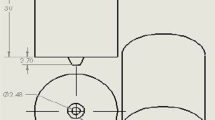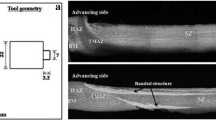Abstract
In this study, the effects of tool rotational speed, tool traverse speed, and Zn content on the grain size and hardness of the friction-stir-welded (FSWed) Cu–Zn alloy joints were investigated. The microstructures of the joints were examined using optical microscope (OM) and scanning transmission electron microscope (STEM). Vickers hardness test was conducted to evaluate the hardness of the joints. In addition, the relationships between the process parameters, grain size, and hardness of the joints were established. The results show that the developed relationships predict the grain size and hardness of the joints accurately. The Zn content of the alloys is the most effective parameter on the grain size and hardness, where the tool traverse speed has the minimum effect. The relationship between the hardness and grain size of the joints has a deviation from the Hall–Petch equation due to formation of high dislocation density inside the grains. At higher Zn amounts, the dislocation tangles with high density form instead of dislocation cells, and hence, lower conformity with the Hall–Petch relationship is observed.







Similar content being viewed by others
References
Nandan R, DebRoy T, Bhadeshia HKDH. Recent advances in friction-stir welding-process, weldment structure and properties. Prog Mater Sci. 2008;53(6):980.
Heidarzadeh A, Saeid T. A comparative study of microstructure and mechanical properties between friction stir welded single and double phase brass alloys. Mater Sci Eng A. 2016;649:349.
Çam G. Friction stir welded structural materials: beyond Al-alloys. Int Mater Rev. 2011;56(1):1.
Heidarzadeh A, Saeid T. On the effect of β phase on the microstructure and mechanical properties of friction stir welded commercial brass alloys. Data in Brief. 2015;5:1022.
Heidarzadeh A, Kazemi-Choobi K, Hanifian H, Asadi P. 3-Microstructural Evolution. In: Givi MKB, Asadi P, editors. Advances in Friction-Stir Welding and Processing. Cambridge: Woodhead Publishing; 2014. 65.
Ambroziak A. Hydrogen damage in friction welded copper joints. Mater Des. 2010;31(8):3869.
Farrokhi H, Heidarzadeh A, Saeid T. Frictions stir welding of copper under different welding parameters and media. Sci Technol Weld Join. 2013;18(8):697.
Galvão I, Leal RM, Rodrigues DM, Loureiro A. Influence of tool shoulder geometry on properties of friction stir welds in thin copper sheets. J Mater Process Technol. 2013;213(2):129.
Heidarzadeh A, Jabbari M, Esmaily M. Prediction of grain size and mechanical properties in friction stir welded pure copper joints using a thermal model. Int J Adv Manuf Technol. 2015;77(9–12):1819.
Hwang YM, Fan PL, Lin CH. Experimental study on friction stir welding of copper metals. J Mater Process Technol. 2010;210(12):1667.
Leal RM, Sakharova N, Vilaça P, Rodrigues DM, Loureiro A. Effect of shoulder cavity and welding parameters on friction stir welding of thin copper sheets. Sci Technol Weld Joining. 2011;16(2):146.
Shen JJ, Liu HJ, Cui F. Effect of welding speed on microstructure and mechanical properties of friction stir welded copper. Mater Des. 2010;31(8):3937.
Sun YF, Fujii H. Investigation of the welding parameter dependent microstructure and mechanical properties of friction stir welded pure copper. Mater Sci Eng A. 2010;527(26):6879.
Xu N, Ueji R, Morisada Y, Fujii H. Modification of mechanical properties of friction stir welded Cu joint by additional liquid CO2 cooling. Mater Des. 2014;56:20.
Çam G, Serindağ HT, Çakan A, Mistikoglu S, Yavuz H. The effect of weld parameters on friction stir welding of brass plates. Materialwiss Werkstofftech. 2008;39(6):394.
Emami S, Saeid T. Effects of welding and rotational speeds on the microstructure and hardness of friction stir welded single-phase brass. Acta Metall Sin (Engl Lett). 2015;28(6):766.
Sun YF, Xu N, Fujii H. The microstructure and mechanical properties of friction stir welded Cu–30Zn brass alloys. Mater Sci Eng A. 2014;589:228.
Xie GM, Ma ZY, Geng L. Effects of friction stir welding parameters on microstructures and mechanical properties of brass joints. Mater Trans. 2008;49(7):1698.
Rajakumar S, Muralidharan C, Balasubramanian V. Predicting tensile strength, hardness and corrosion rate of friction stir welded AA6061–T6 aluminium alloy joints. Mater Des. 2011;32(5):2878.
Palanivel R, Koshy Mathews P. Prediction and optimization of process parameter of friction stir welded AA5083-H111 aluminum alloy using response surface methodology. J Cent South Univ. 2012;19(1):1.
Rajakumar S, Balasubramanian V. Establishing relationships between mechanical properties of aluminium alloys and optimised friction stir welding process parameters. Mater Des. 2012;40:17.
Ghassemali E, Tan M-J, Wah CB, Lim SCV, Jarfors AEW. Effect of cold-work on the Hall–Petch breakdown in copper based micro-components. Mech Mater. 2015;80:124.
Park S, Sato Y, Kokawa H. Microstructural evolution and its effect on Hall–Petch relationship in friction stir welding of thixomolded Mg alloy AZ91D. J Mater Sci. 2003;38(21):4379.
Azadbeh M, Mohammadzadeh A, Danninger H. Modeling the response of physical and mechanical properties of Cr–Mo prealloyed sintered steels to key manufacturing parameters. Mater Des. 2014;55:633.
Azadbeh M, Mohammadzadeh A, Danninger H, Gierl-Mayer C. On the densification and elastic modulus of sintered Cr–Mo steels. Metall Mater Trans B. 2015;46(3):1471.
Mohammadzadeh A, Azadbeh M, Danninger H. New concept in analysis of supersolidus liquid phase sintering of alpha brass. Powder Metall. 2015;58(2):123.
Mohammadzadeh A, Azadbeh M, Danninger H. Microstructural coarsening during supersolidus liquid phase sintering of alpha brass. Powder Metall. 2015;58(4):300.
Mohammadzadeh A, Azadbeh M, Namini SA. Densification and volumetric change during supersolidus liquid phase sintering of prealloyed brass Cu28Zn powder: modeling and optimization. Sci Sinter. 2014;46(1):23.
Mozammel M, Mohammadzadeh A. The influence of pre-oxidation and leaching parameters on Iranian ilmenite concentrate leaching efficiency: optimization and measurement. Measurement. 2015;66:184.
Heidarzadeh A, Barenji R, Esmaily M, Ilkhichi A. Tensile properties of friction stir welds of AA 7020 aluminum alloy. Trans Indian Inst Met. 2015;68(5):757.
Heidarzadeh A, Saeid T, Khodaverdizadeh H, Mahmoudi A, Nazari E. Establishing a mathematical model to predict the tensile strength of friction stir welded pure copper joints. Metall Mater Trans B. 2013;44(1):175.
McNelley TR, Swaminathan S, Su JQ. Recrystallization mechanisms during friction stir welding/processing of aluminum alloys. Scr Mater. 2008;58(5):349.
Commin L, Dumont M, Masse JE, Barrallier L. Friction stir welding of AZ31 magnesium alloy rolled sheets: influence of processing parameters. Acta Mater. 2009;57(2):326.
Arora A, De A, DebRoy T. Toward optimum friction stir welding tool shoulder diameter. Scr Mater. 2011;64(1):9.
Mohamed FA. A dislocation model for the minimum grain size obtainable by milling. Acta Mater. 2003;51(14):4107.
Parvin H, Kazeminezhad M. Dependency modeling of steady state grain size on the stacking fault energy through severe plastic deformation. Mater Lett. 2015;159:410.
Qu S, An XH, Yang HJ, Huang CX, Yang G, Zang QS, Wang ZG, Wu SD, Zhang ZF. Microstructural evolution and mechanical properties of Cu–Al alloys subjected to equal channel angular pressing. Acta Mater. 2009;57(5):1586.
Huang CX, Hu W, Yang G, Zhang ZF, Wu SD, Wang QY, Gottstein G. The effect of stacking fault energy on equilibrium grain size and tensile properties of nanostructured copper and copper–aluminum alloys processed by equal channel angular pressing. Mater Sci Eng A. 2012;556:638.
Cai B, Tao J, Wang W, Yang X, Gong Y, Cheng L, Zhu X. The effect of stacking fault energy on equilibrium grain size and tensile properties of ultrafine-grained Cu–Al–Zn alloys processed by rolling. J Alloys Compd. 2014;610:224.
Morishige T, Hirata T, Uesugi T, Takigawa Y, Tsujikawa M, Higashi K. Effect of Mg content on the minimum grain size of Al–Mg alloys obtained by friction stir processing. Scr Mater. 2011;64(4):355.
Gallagher PCJ. The influence of alloying, temperature, and related effects on the stacking fault energy. Metall Mater Trans B. 1970;1(9):2429.
Zhao YH, Zhu YT, Liao XZ, Horita Z, Langdon TG. Influence of stacking fault energy on the minimum grain size achieved in severe plastic deformation. Mater Sci Eng A. 2007;463(1–2):22.
Du D, Fu R, Li Y, Jing L, Wang J, Ren Y, Yang K. Modification of the Hall–Petch equation for friction-stir-processing microstructures of high-nitrogen steel. Mater Sci Eng A. 2015;640:190.
Gao C, Zhu Z, Han J, Li H. Correlation of microstructure and mechanical properties in friction stir welded 2198-T8 Al–Li alloy. Mater Sci Eng A. 2015;639:489.
Sato Y, Park S, Kokawa H. Microstructural factors governing hardness in friction-stir welds of solid-solution-hardened Al alloys. Metall Mater Trans A. 2001;32(12):3033.
Jones MJ, Heurtier P, Desrayaud C, Montheillet F, Allehaux D, Driver JH. Correlation between microstructure and microhardness in a friction stir welded 2024 aluminium alloy. Scr Mater. 2005;52(8):693.
Sato YS, Urata M, Kokawa H, Ikeda K. Hall–Petch relationship in friction stir welds of equal channel angular-pressed aluminium alloys. Mater Sci Eng A. 2003;354(1–2):298.
Author information
Authors and Affiliations
Corresponding author
Rights and permissions
About this article
Cite this article
Heidarzadeh, A., Saeid, T. Correlation between process parameters, grain size and hardness of friction-stir-welded Cu–Zn alloys. Rare Met. 37, 388–398 (2018). https://doi.org/10.1007/s12598-016-0704-9
Received:
Revised:
Accepted:
Published:
Issue Date:
DOI: https://doi.org/10.1007/s12598-016-0704-9




